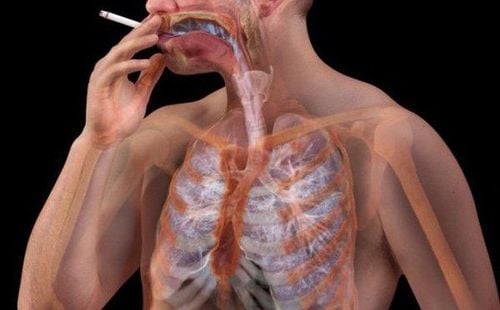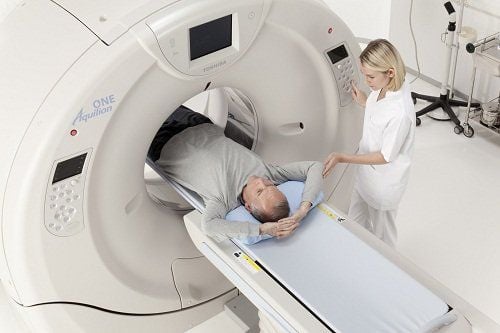This is an automatically translated article.
Throat cancer is a disease that develops in the organs that help you swallow, speak and breathe. This is a dangerous disease with a high mortality rate, actively seeking knowledge related to oropharyngeal cancer will help protect the health of themselves and their families.
1. Symptoms of nasopharyngeal cancer
About half of nasopharyngeal cancers occur in the throat itself. It is a cavity that begins at the back of the nose and ends at the neck. Such a cancer site is called the oropharynx. The remaining half of nasopharyngeal cancers begin in the larynx. Some of the symptoms include:
Voice change: Cracked or hoarse voice Difficulty swallowing or breathing Sore throat, cough, or earache Headache Clumping neck Unexplained weight loss You should see your doctor right away if any of these symptoms persist for more than a few weeks.

Bệnh nhân ung thư vòm họng sẽ thấy khó thở
2. Risk factors leading to oropharyngeal cancer
Several factors are thought to cause oropharyngeal cancer including:
Long-term smoking: This is the biggest risk factor for all cancers of the head and neck, including oropharyngeal cancer. Drinking heavily and regularly: Men who drink more than two glasses of wine per day or women who drink more than one drink per day have a higher risk of oropharyngeal cancer than the general population. HPV: Human papillomavirus can cause cancers in the back of the throat, including cancer of the tongue and tonsils. HPV-associated nasopharyngeal cancer is preventable at an early age with the HPV vaccine. Children should start getting shots between the ages of 11 and 12. Other risk factors include:
Gender: Men are five times more likely to get the disease than women. Nasopharyngeal cancer in women has a lower rate. Age: Almost all cases are detected after age 65. Race: African-American men have the highest risk of oropharyngeal cancer. Chemical exposure: exposure to asbestos fumes, nickel and sulfuric acid.

Thuốc lá là nguyên nhân hàng đầu gây ung thư vòm họng
3. Types of nasopharyngeal cancer
Most types develop in the flat and thin cells that connect the throat and larynx.
Location of nasopharyngeal cancer:
Oropharynx: The cavity in the upper part of your throat and just behind your nose. In the United States, cancer in this location is rare. Oropharynx: The cavity immediately after opening the mouth, cancer can develop in the tonsils, at the base of the tongue, or the soft palate. Hypopharynx: Lower pharynx, which is the narrowest and lowest area just behind the larynx, cancer can originate from 3 areas of the larynx including: glottis: From your 2 vocal cords Upper glottis: The area above 2 vocal cords Subglottic larynx: The area below the vocal cords and above the trachea

Ung thư vòm họng có thể xuất hiện ở nhiều vị trí
4. Diagnosis of nasopharyngeal cancer
Your doctor will examine you and ask about your general health, smoking habits, drinking habits, and sexual behavior. Your doctor may also use devices to get a closer look at your throat.
If your doctor thinks you may have nasopharyngeal cancer, he or she will order the necessary tests, depending on the type of cancer. Common tests include:
Biopsy: The examiner collects a sample of tissue to look at under a microscope to look for cancer cells. It is the only way to know for sure if the tumor a person is suffering from is cancerous or not a benign nasopharyngeal tumor. Biopsy will be done through surgery, needle or endoscope Some imaging tests: PET Scan, X-ray, MRI or CT

Chụp cắt lớp vi tính giúp chẩn đoán tình trạng ung thư vòm họng
Imaging tests can help doctors detect tumors. They also help the doctor determine the location, size, and spread of the tumor.
If nasopharyngeal cancer is detected, the specimen can be tested for the virus. Generally, a patient's health prognosis is better if the cancer is related to the HPV virus, compared to a patient with cancer related to smoking.
5. Stages of nasopharyngeal cancer
Each type of nasopharyngeal cancer has different stages of cancer that reflect the different severity of the disease.
Stages I and II are cancers that are smaller in size and still located in an area of the organ that has not metastasized. Stage III may have spread to the lymph nodes or other parts of the throat. Stage IV may have spread to the lymph nodes and different parts of the head, neck, or chest. The most severe stage IV cancers have spread to distant parts of the body such as the lungs or liver.
6. Methods of treatment for nasopharyngeal cancer
Throat cancer tends to progress rapidly, so early detection of oropharyngeal cancer and early treatment will help patients have a better prognosis in treatment and ensure quality of life after treatment. treat. You should learn as much about nasopharyngeal cancer as possible so that it can be prevented, detected, and treated as early as possible. The cure rate for nasopharyngeal cancer depends on the stage.
The principle of treatment is that doctors will try to remove the tumor, keep the cancer from spreading, and preserve the patient's ability to swallow and speak as much as possible.
Your treatment will depend on:
The stage of the cancer The location of the tumor The patient's general health The patient's choice

Bệnh nhân ung thư vòm họng có thể lựa chọn phương pháp xạ trị để điều trị bệnh
Patients can be treated for nasopharyngeal cancer with one or more of the following treatments:
Radiation: A method that uses high-energy rays to destroy cancer cells. This procedure can be done outside the body or inside the body with radioactive particles that are implanted near the cancer area. Usually, radiation therapy is only used for patients with early-stage nasopharyngeal cancer, but it can also be used with chemotherapy or surgery to treat later-stage disease. Surgery: Can be done through scalpel techniques. It can also be less invasive procedures - oral surgery through an endoscope, or with a laser or robotic technique. Early-stage cancers can also be treated through endoscopy or lasers. If your cancer has invaded the surrounding area, or has spread to parts or all of your larynx or pharynx, your doctor will perform a resection. This treatment may affect your ability to swallow, breathe, or speak normally.
Doctors may transplant tissue taken from another part of your body to reshape parts of your throat to help you swallow. If you have a laryngectomy, your surgeon will attach your windpipe to a hole in your neck, called a stoma, so you can breathe. If the cancer has spread deeper into your neck, your surgeon may perform lymph node dissection.
Chemotherapy drugs can kill cancer and stop it from spreading. It may be used before surgery to shrink a tumor, or afterward to keep it from coming back. Some chemotherapy drugs can make radiation therapy work better. The drug targets to starve cancer cells by preventing the cancer cells from getting the nutrients they need to grow.
Your doctor can prescribe medicine for you to help you manage your pain. You may have discomfort problems during or after your treatment. Experts can:
Show you how to care for a wound Teach you to speak if you have no vocal cords Find a way to swallow or eat easier Help you recover
7. What should you do to take care of yourself during and after treatment?
Treatment can make you feel tired. So get enough rest, exercise when you can, and maintain your diet with healthy foods, like fruits and vegetables.
Quit smoking and limit alcohol: Smoking and drinking can make treatments less effective and they increase the risk of other cancers.

Tránh xa thuốc lá giúp người bệnh điều trị bệnh hiệu quả hơn
Go for routine checkups after treatment: Your doctor will monitor you closely for the first few years to monitor and look for signs that the cancer has returned.
Early cancer screening is considered a perfect measure in the timely detection and treatment of all types of cancer. Reduce the cost of treatment and especially reduce the mortality rate in patients. Vinmec International General Hospital always deploys and introduces to customers a HIGH-TECH CANCER CHECKLIST PACKAGE to help with gene testing, imaging, and biomarkers for early tumor detection. Vinmec International General Hospital has many packages of early cancer screening.
Only one gene test can assess the risk of 16 common cancers in both men and women (lung cancer, colorectal cancer, breast cancer, pancreatic cancer, neck cancer) uterus, stomach cancer, prostate cancer,....) Early detection of early signs of cancer through imaging, endoscopy and ultrasound. The operation is simple, careful and accurate. A team of well-trained specialists, especially in oncology, are capable of handling cancer cases. With facilities, advanced and modern medical equipment and a team of doctors with deep expertise and experience. At Vinmec, the examination process becomes fast with accurate results, saving costs and time for patients.
Please dial HOTLINE for more information or register for an appointment HERE. Download MyVinmec app to make appointments faster and to manage your bookings easily.
Reference source: webmd.comMORE
Is nasopharyngeal cancer contagious? How to detect oropharyngeal cancer Differentiate nasopharyngeal cancer and common pharyngitis













